Sitting outside Linnane’s Lobster Bar on the Flaggy Shore in Co Clare, about to enjoy a feed of oysters, sister and brother Lilia and Ciarán Tyrrell from Montana and New York are explaining the appeal of the Burren. I don’t tell them it has been chosen as the best place to holiday in Ireland by The Irish Times, a summer competition supported by Fáilte Ireland. The news is still a secret when I meet them. It soon becomes apparent that they already know the Burren is the best.
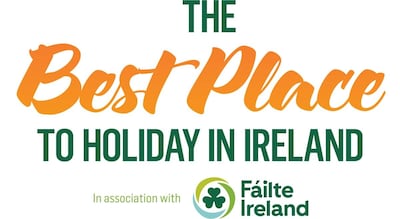
In May this year, The Irish Times began its search for the Best Place to Holiday in Ireland 2022, in association with Fáilte Ireland. Some 1,200 people from 32 counties sent in entries, which were put in front of our panel of judges. After weeks of research and deliberation, they chose the Burren as the winner – beating stiff competition from Carlingford in Co Louth, the Antrim Coast, and the islands of Achill and Inishbofin.
“I’m asked all the time by Americans, where should I go on holiday in Ireland,” says Lilia, brown eyes glinting with enthusiasm for this far-flung patch of the west of Ireland. She doesn’t want any Dubliners to take offence, but when she is asked this question, she always answers the same way: “I tell them to leave Dublin immediately, head west and go to the Burren.”
Why? “So many reasons. The people are extraordinary, the food is extraordinary, the wild flowers, the scenery, the rugged coastline, the traditional music. The Burren is Ireland at its very best. You cannot get more quintessentially Irish than this place. It has everything.”
Mark O’Connell: Meet Romulus and Remus, first of their kind for 10,000 years. Sort of
‘My son was killed in front of my eyes. Three bullets in his chest’: Patrick Freyne in Chad’s desert camps
Wealth gap tensions: ‘My friends don’t have to budget like me. A round of cocktails scares the s**t out of me’
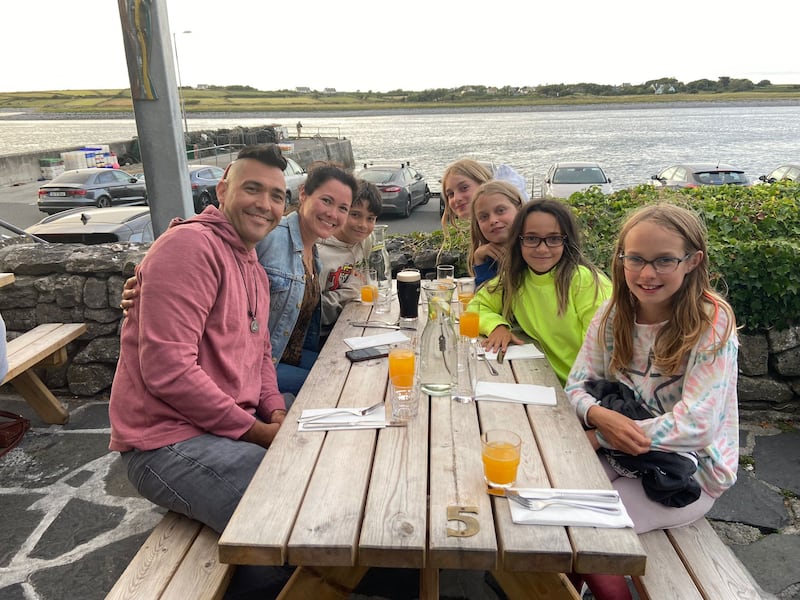
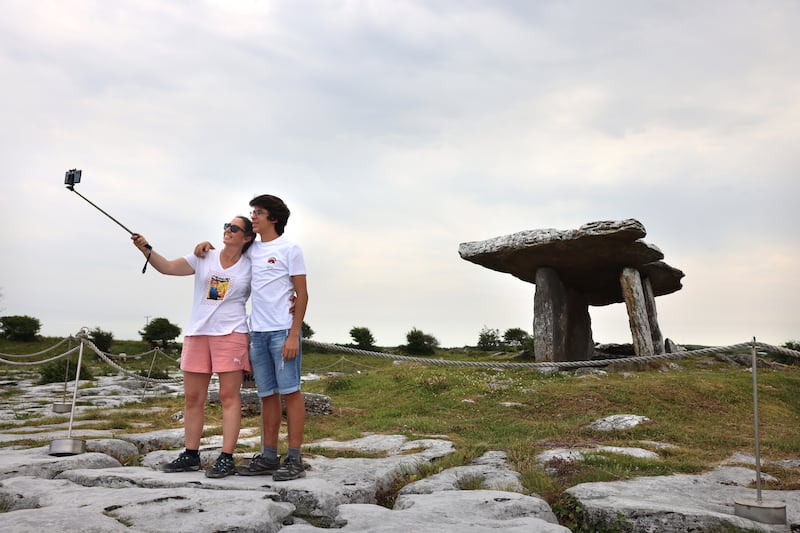
Lilia and Ciarán’s father was Galway man Seán Tyrrell, the traditional singer who died last year after living in the area for 45 years. The siblings have returned to the Burren for summer holidays for years. They were born in Ireland but moved to the United States with their mother as small children.
Their visits to the Burren are almost sacred. “It’s our spiritual home,” says Lilia, describing how the Burren moves them. “We come up over that hill from Kinvara and we see the stones and we always cry.” Ciarán says: “I arrived this morning, and I burst into tears.” Their words make you think of Seamus Heaney’s poem Postscript, which is displayed further down the shore from Linnane’s. Heaney famously described this area as a place that can “catch the heart off guard and blow it open”.
It’s close to twilight now. Empty lobster pots are stacked on the pier above the rippling sea. They were once children here on summer holidays, now as adults Ciarán and Lilia bring their own children to the Burren. Aged between nine and 12, the five of them sit at a wooden table waiting patiently with glasses of fizzy orange for their gigas and their dainties, oysters brought up that morning from the waters of the Flaggy Shore. “I wish the Burren was my back garden,” says one of the children.
Saying goodbye to the Tyrrells, I’m already looking forward to the drive back towards Ballyvaughan where I’m spending the night at Monks on the pier. Like them, I’ve been coming on holiday to this place for years. This coastal road, with those mesmerising Burren rocks laid out on either side and the Atlantic Ocean beyond, is one of the most spectacular drives in Ireland. After a mostly overcast day, the light is suddenly golden with late sunshine the way everything can change in an instant when you’re this far west. The slate grey limestone on the hills is shot through with an almost lavender tinge. A stop for a sunset swim at the Blue Flag Fanore Beach is irresistible. There are some walkers about, you catch French and German accents, but there’s nobody else in the water. An ocean swim alone as the sun glows and then dips is one of those unforgettable Burren moments.
In their comments, the judges in the competition all pointed to the uniqueness of the area, the originality and diversity of the ecosystem, that compelling, desolate landscape. To understand the place even better, beyond sunset swims and childhood memories of the stalactites in the Aillwee Caves, I take a guided walk with Phoebe Larkin, head guide at the Burren National Park.
She’s a local woman – on the shuttle bus ride from the park’s Information Point at Corofin she points out the school she attended as a child. The shuttle buses run several times a day to and from Corofin, dropping walkers up to the trails so the roads don’t get too clogged by cars. The bus service and the walks are free, but an hour and a half with Larkin in the Burren is priceless.
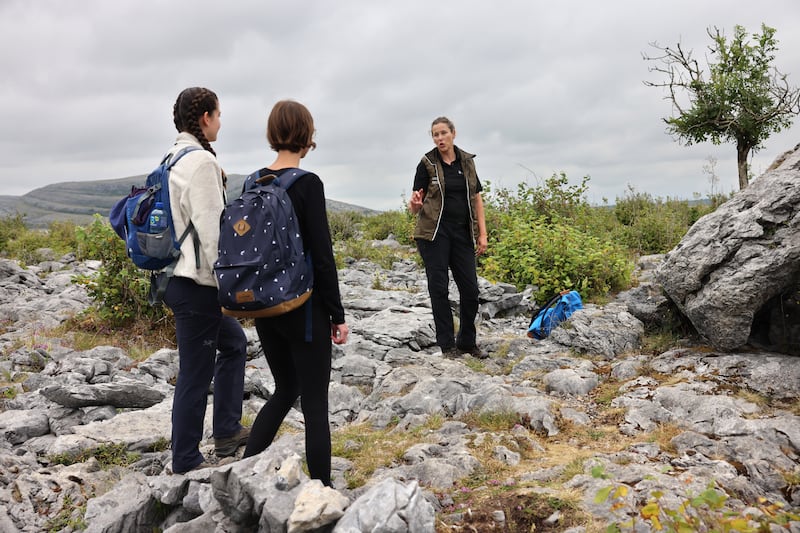
Also on the walk are two young women from Lucerne in Switzerland. Larkin takes us on a walk, pointing out nature we’d never have noticed if we weren’t with her; ant hills at our feet, and rare examples of lichen on the branches of trees known as Atlantic rainforests. She shows us wild thyme and marjoram, quaking grass and yellow wort.
We stop in a place with a view of the stony mountain Mullaghmore. Larkin tells us that the distinctive limestone landscape was all formed 350 million years ago, when Ireland was part of a much larger land mass south of the equator. We’re standing on what millions of years ago would have been a shallow tropical sea. She points out the intricacies of the fossilised coral at our feet. The limestone that is everywhere has also been described as a mass grave of millions of sea creatures, shells and skeletal remains, compressed into rock over millions of years.
Larkin points out geographical structures such as grikes, vertical cracks in the rock eroded by rainfall. She tells us about the water systems and caves beneath us, and shows us all the life bursting from the cracks, cultivated by the micro climates under the Burren.
We walk through mature hazel woods and wild flower meadows. There’s a ruin of a famine era building. The hazel wood is managed, Larkin explains, because if it is let grow it will take over the limestone and crowd out the unique flora.
Ireland’s last ice age finished 12,000 years ago and the glaciers left behind features such as the boulders and standing stones, the “glacial erratics” you can see all over the Burren. Larkin explains that 6,000 years ago, when the first people arrived here, the place would have been covered with trees – Scots pine, oak, ash and hazel – all supported by a thin layer of soil. The first farmers cleared the trees and the remaining thin soils blew off, creating the landscape we know as the Burren, the Irish word for rocky place.
“It’s actually a man-made landscape even though it’s thousands of years old, and because the limestone was exposed, that’s how we have the unique flora. You hear a lot about rewilding, letting places grow wild and back to nature. If you did that in the Burren, it would be taken over by hazel woods and you would lose all those unique flowers and plants. Eventually there wouldn’t be any Burren any more.”
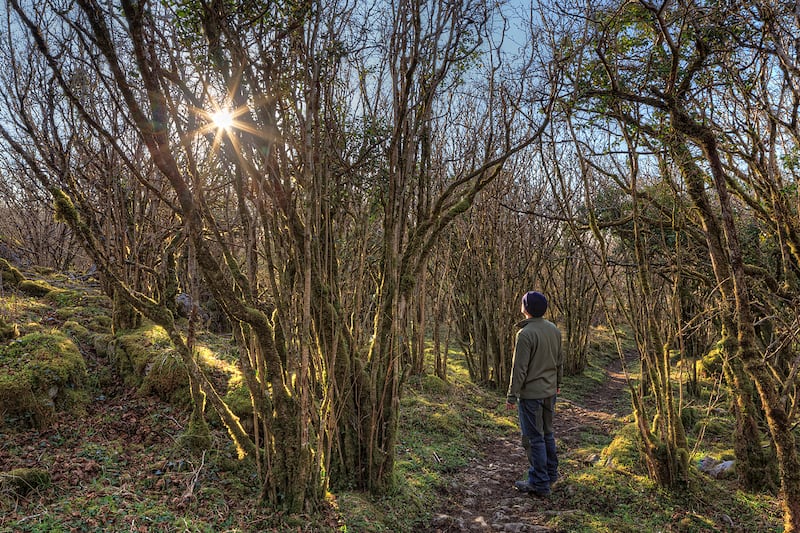
She tells us about the wildlife, the massive herds of feral goats roaming free, about the red foxes, squirrels and stoats. About a seven-year-old boy, who came on a walk recently, carrying binoculars and a book about Burren flowers. “He knew everything,” Larkin says. “He was mad for the orchids.”
Larkin is mad for the orchids too. “Obsessed,” she says, explaining that there are 27 wild species of orchids in Ireland, and 25 of them can be found in the Burren. She points to common spotted orchids and the sweetly scented fragrant orchids. “If an orchid seed lands somewhere that’s not suitable for growth, it can lie dormant for 15 years,” she says. “I stopped mowing my lawn at home six years ago and got my first orchid last year.”

You could listen to Larkin all day, but it’s time for lunch. It’s a short drive to the Burren Perfumery which is a favourite spot, for the walk around the garden and the shop selling lotions and potions made from local flowers and plants. Everything in the cafe is homemade and local, from the coffee cake to the St Tola’s goats cheese on ciabatta to the mackerel in the exceptional pâté. Outside, as small birds hop about stone walls and butterflies hover, a woman is drinking tea. I ask what she thinks of the Burren.
“It’s fascinating,” says Achla, from Delhi, in India. “I knew about the Cliffs of Moher and the Aran Islands, but I did not know about the Burren itself.” She says it reminded her of the Ladakh region of India, the stillness and the quietude of the place.
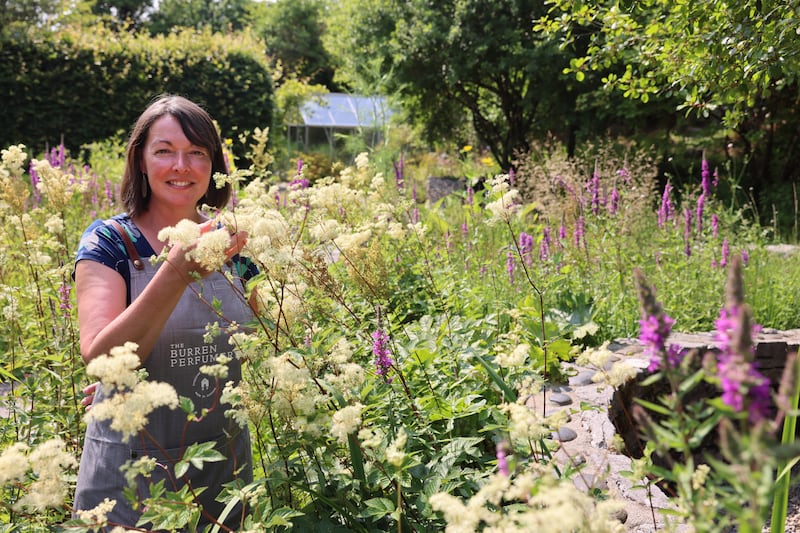
Heatmaps of the Burren reveal an unusually high concentration of ancient monuments, forts and tombs, another feature that makes this place stand out from other destinations. Not far away, at the car park near the Poulnabroune Dolmen, Thomas Coyne sits at his stall selling handmade jewellery. He’s known as Tap Tap around these parts, because of the sound he makes hammering out his jewellery. He lowers down the traditional music he has blaring from the stall. Music is one of many things he loves about this area.
“Whether you go to Doolin, Ballyvaughan or Lisdoonvarna or anywhere in the Burren there is great music,” he says. “It attracts people from all over.” Coyne is from Dublin but his grandfather was from Co Clare, so he feels rooted in the area. He has a deep interest in paganism and appreciates the high concentration of monuments like Poulnabroune in such a small area.
What’s the appeal of the Burren? “There is so much for people here, the music, the cliffs, the islands, archaeology, the sea, the heritage. It’s got everything and it’s full of surprises,” he says.
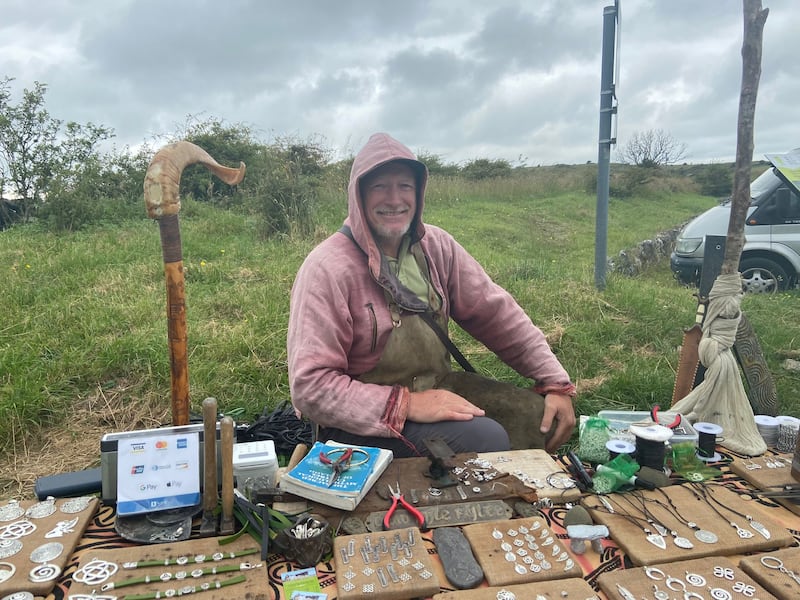
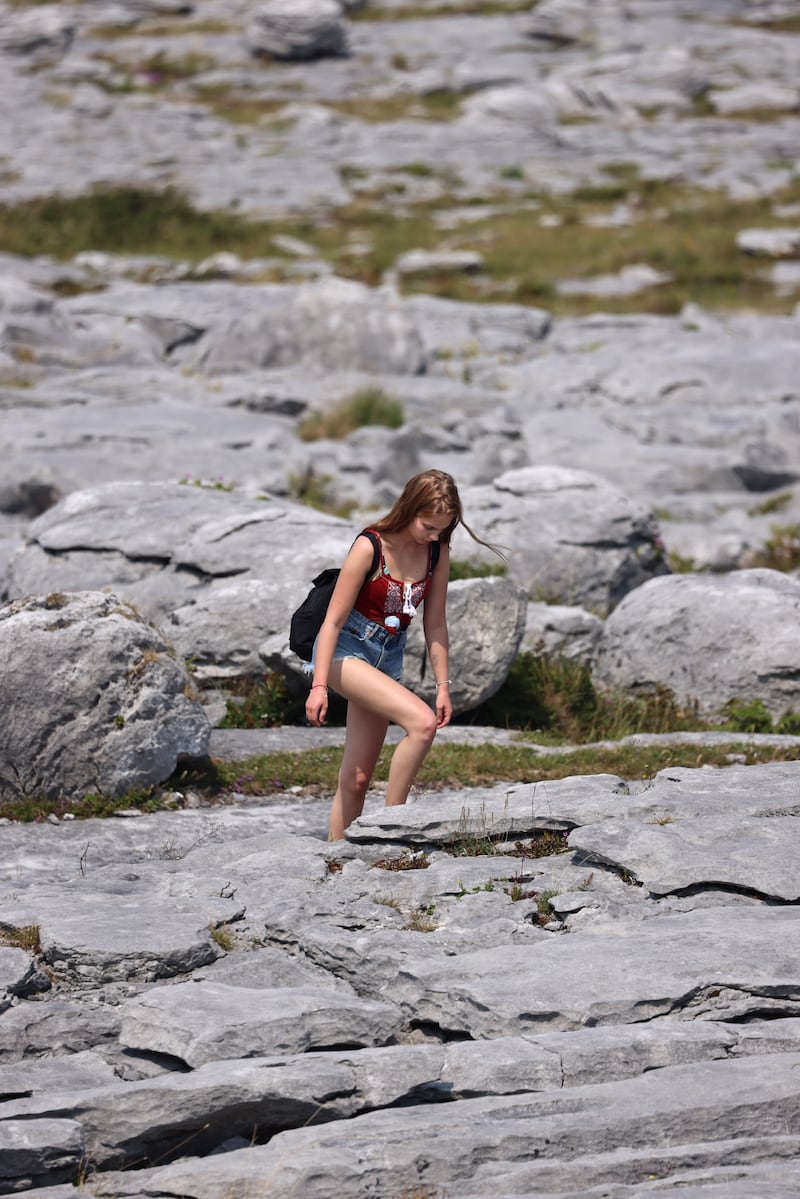
Shauna Brown from Tipperary lived in South Korea before she came to Ballyvaughan, where she is front of house manager at Monks on the pier. She remembers the first time she arrived, that drive from Ennis, passing Leamaneh Castle “and then you come into Corofin, there’s one part of the road, you see the Burren out in front of you and it looks like Mars. That sold the place to me. The Burren is untouched and undiscovered, you can’t say that about many other places.”
Brown did a masters in tourism and her dissertation was on the Burren and the Cliffs of Moher. She was particularly interested in how locals view tourism in the area. “What I was told overwhelmingly by locals was that they want more tourists to come, but not on a bus,” she says, addressing what is something of a source of tension locally – the continued expansion of the Cliffs of Moher as a visitor experience.
“What locals want is for people to stay, to experience what life is actually like here. You have your honeypots like the Cliffs of Moher, people come and see it for two hours and then leave, but those people are missing out. The people here and the life here needs to be experienced; you don’t get that in a couple of hours.” You’ll hear this all the time from locals and it’s true: while they are magnificent, the Burren contains so much more than the cliffs.
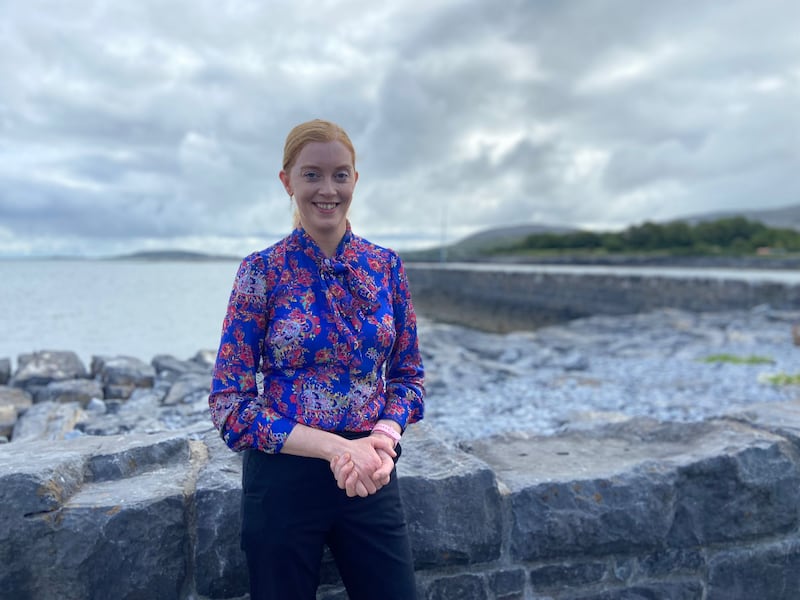
There are new attractions opening all the time, Brown says. She has just been down to the new Flaggy Shore Oyster Experience in New Quay. “You learn everything about oysters from how they’re harvested to shucking them and you get to eat them of course”.
She raves about O Loclainn’s pub in Ballyvaughan. “No phones, no televisions, just a proper Irish pub where you will have the best conversations. I haven’t found a place like that anywhere else in Ireland. We don’t take visitors for granted, in the Burren. We treat people like individuals, we want to know their stories and how they ended up here. People are curious. I think that’s unique to the Burren.”
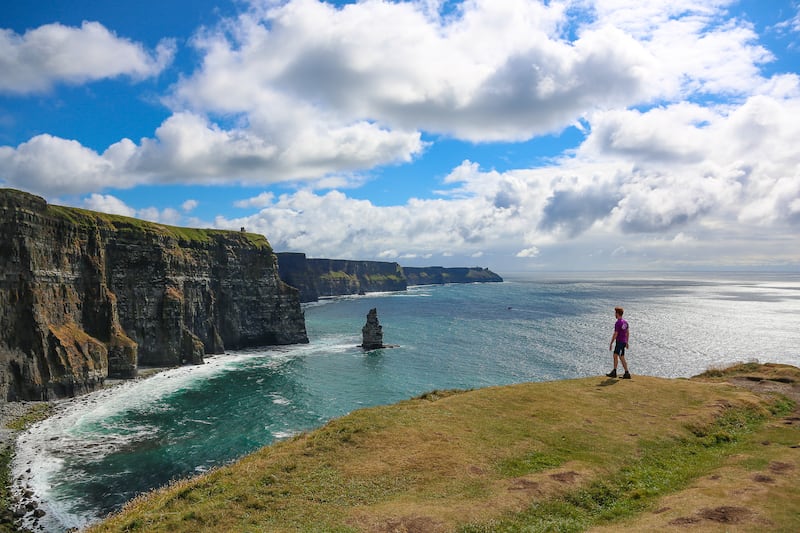
The welcome extends to Ukrainians, who, since the war, have made temporary homes in hotels and guest houses all over the area and are working in tourism businesses too.
The tourist season, Brown says, is getting longer and she hopes that will continue. Monks on the pier, with beautifully renovated guest rooms and fish and chips people travel miles to taste, now stays open all year round. Monks is part of the Burren Ecotourism Network, a group of more than 50 local businesses which pool their talents to attract more people to the area.
“If you are talking about a destination, everyone has to be on the same page,” she says. “You want people to be able to come here in 10, 20 years. So the efforts we make now will keep the Burren thriving as a destination for people into the future. We try to have a clean way of doing things, keeping the water clean, recycling, sourcing our food as close as we can to our businesses. We all work together here and it really pays off.”
In Lisdoonvarna, Birgitta Curtin and Jarlath O’Dwyer are eager to talk about this business network and about why the Burren is so special. In 2019 O’Dwyer, who has worked in hospitality all over the world including with Fáilte Ireland and the Soho Hotel Group, is chief executive of the Burren Ecotourism Network.
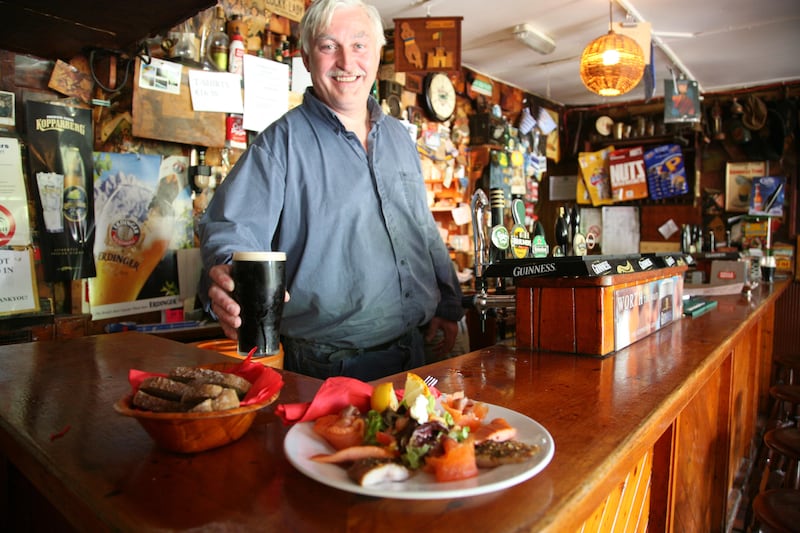
Curtin, one of the founding members of the network, came here from Sweden in the 1980s, and was “blown away” by the culture, the music, the landscape. She was 18 when she met and fell in love with local man Peter Curtin. After studying marine biology and botany in Galway, the couple opened the Burren Smokehouse and began producing the smoked salmon that is now synonymous with the Burren.
“I was inspired from my own experiences in Sweden, where we foraged and fished and brought the fish to the local smokehouse. It’s that concept of the very best, locally sourced, artisan produced and selling in small batches.”
Lisdoonvarna was “in the middle of nowhere” but close enough to the monster tourist attraction that is the Cliffs of Moher, so they had passing trade. They opened in 1989. “It gives people the opportunity to taste something from the Burren as they pass through,” says Birgitta.
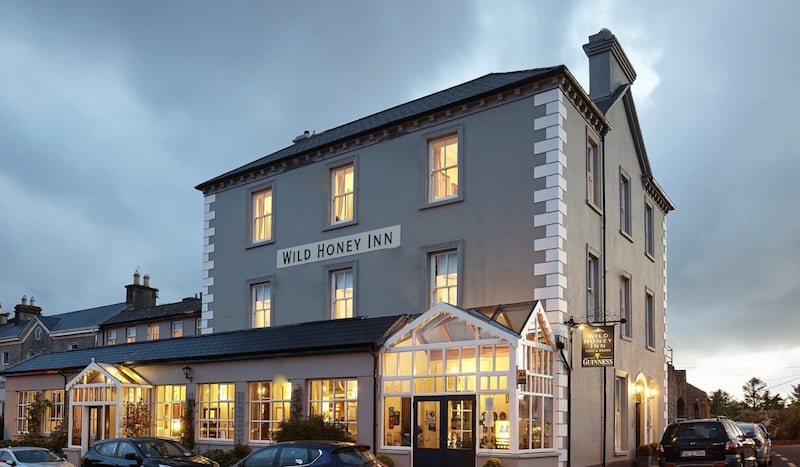
In recent years, as well as tours of the smokehouse, the Taste of the Atlantic centre opened, telling the story of salmon in Ireland. The couple also own the Roadside Tavern, where Peter Curtin has a micro brewery. The visitor experience includes a storytelling session tailored to each guest, whether they are interested in local folklore or the history of the area or the technical aspects of brewing. It is just one of a growing number of food trails and experiences being offered in the Burren. The Wild Honey Inn is nearby, Ireland’s only Michelin starred pub restaurant run by chef Aidan McGrath.
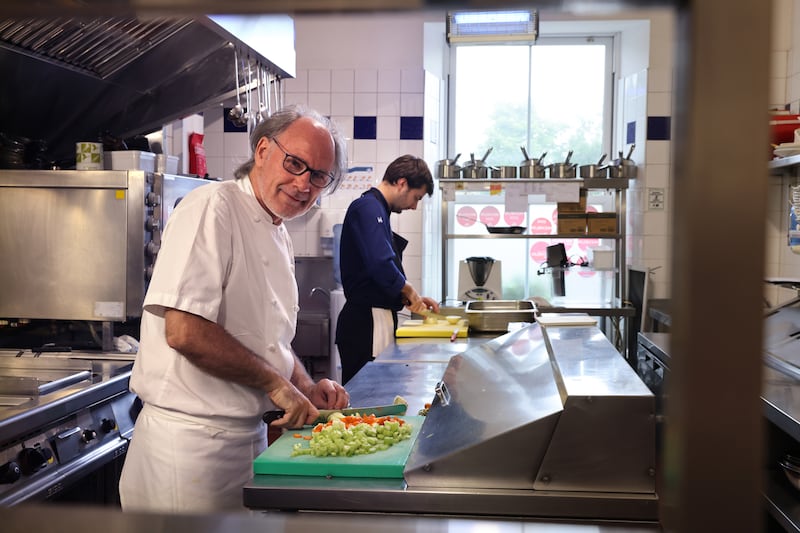
This is all very personal for O’Dwyer. “The Burren is the land of our ancestors, the land of our heritage, going back eight or nine generations my family would have farmed their cattle around Fanore.” O’Dwyer explains that in the past 10 years the Burren Ecotourism Network has become as much about “conservation and sustainability” as it is about marketing.
“Most of our members are even more passionate about that than they are promoting the place,” he says. All members pay an annual fee and sign up to a code. It’s a bit of a mouthful: the Burren and Cliffs of Moher Unesco Global Geopark Code of Practice. The code, O’Dwyer says, promotes responsible and sustainable tourism. There is a “leave no trace” policy, regular beach clean-ups and recycling initiatives, members are encouraged to make improvements in how they handle their waste, water and energy.
“The network has been a great way to harness the talent of individual members. Even during the pandemic you had 60 or 70 businesses coming together on Zoom calls.” From these meetings came the inspiration for a cookbook, Burren Dinners and Burren Baskets, an ecommerce development where a “taste of the Burren” from St Tola Goat’s Cheese to Burren Smoked Salmon was sent all over the world. The past 3½ years have been, he says, a “dream life” engaging with people who not only want to promote the area, but who want to protect it too.
There are so many places and providers to shout about including Hazel Mountain Chocolate, Burren Yoga, the brilliant boat trips from Doolin, Caherconnell Fort and the Burren Farm Experience. There is accommodation to suit every budget, from camping to castles.
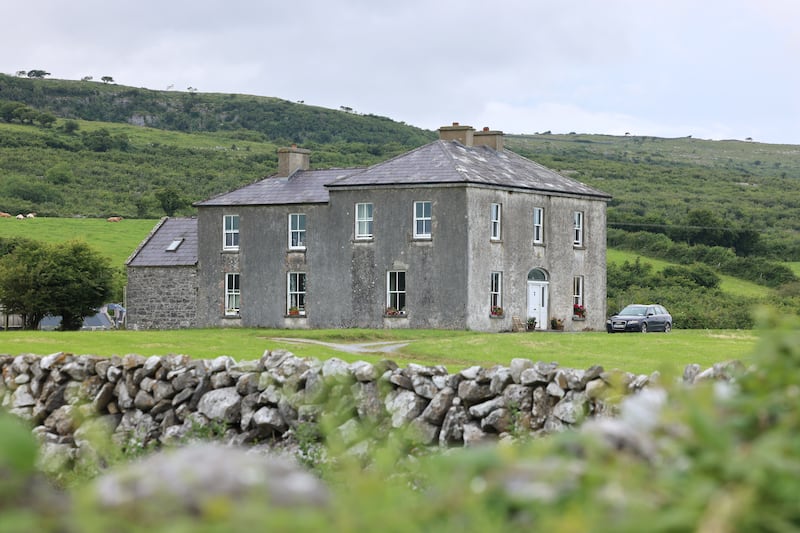
As much as anything else, when you visit the Burren, it’s the people who will stay with you. Back when I met the Tyrrells at the Flaggy Shore, they told me about Mary O’Dea, an eighth-generation Burren farmer and land walker. “You have to talk to Mary,” Lilia Tyrrell told me. “She knows everything about the Burren.” So I leave Lisdoonvarna to meet her in a service station near Kinvara. O’Dea is driving an old jeep. I follow her out the road to where she owns farmland. There are bees and cows and ancient stone walls. She and her family are from Carran in the middle of the Burren, their earliest family gravestones are from the 1600s.
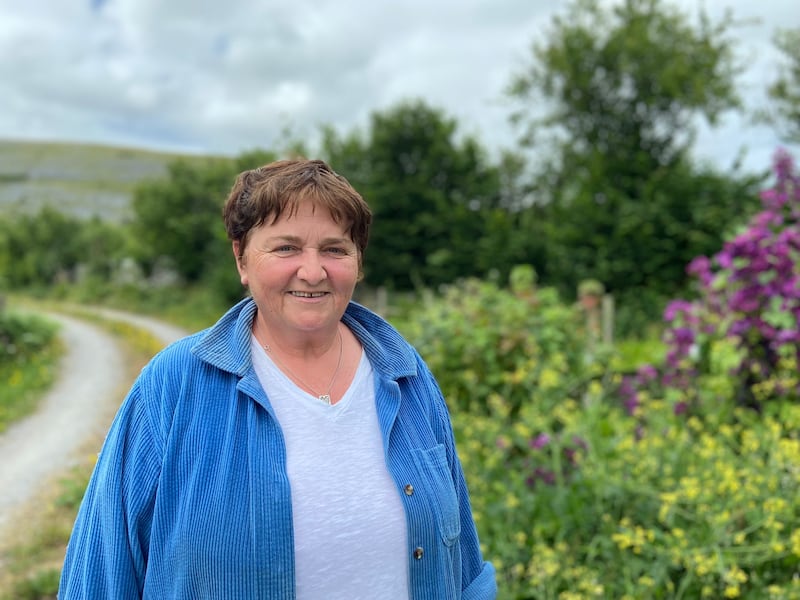
I ask her about the Burren as a place to holiday. “I’ll tell you from the heart,” she says. “I think the Burren needs to be preserved. There are money-making words like ecotourism and sustainability and mindfulness. For me, soul is the only word. If you have soul in a place, you will lose it by having too much tourism. Even though I try to make money out of it too. So it’s a double-edged sword.”
O’Dea is not part of the Burren Ecotourism Network. She runs Hidden Burren, offering private walks. She’s a lone ranger with a profound affection for the place. She’s the kind of character you meet when you get deeper into the Burren, when you spend more than a couple of coach trip hours in the place.
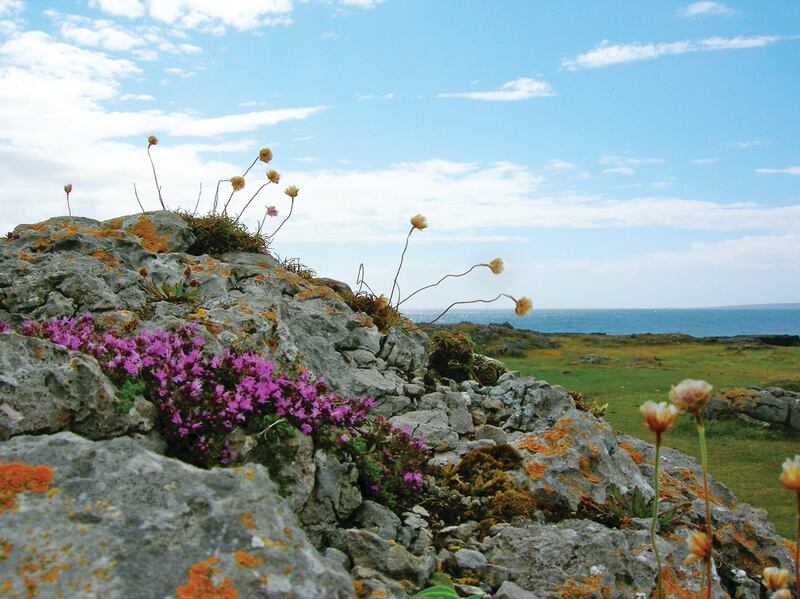
She likes taking people up to Colman’s Bed, in the Burren National Park. “When you are up on the rocks, taking care where you are walking in case you break an ankle, you are thinking about nothing else. It clears your head. Leaving the rough terrain of the crag, there’s a beautiful area of trees, ferns and mosses, it’s like something out of middle earth. A place of calm and imagination. It’s not like anywhere else.”
I get back in the car, and follow Mary to Traught Beach. It’s her favourite spot to swim. There are pristine toilet facilities, picnic benches and a clear, silky grey-blue sea, looking out over Galway Bay. In the water, O’Dea does the back crawl, strong even strokes. Then she treads water and we talk. She says the transition back to the first busy post-pandemic tourist season hasn’t been seamless.
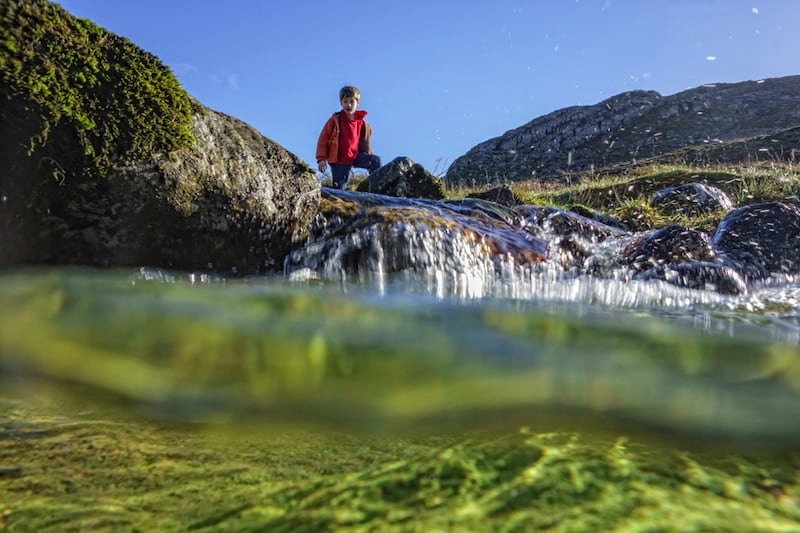
During Covid times, locals had the place returned to them. Her 90-year-old mother could walk the roads because they were not clogged with tourist buses. Fanore Beach was empty except for people from the area. “It felt,” she says, “as though the place was ours again, like it was restored to us. And if we felt like that, I think nature felt the same way.”
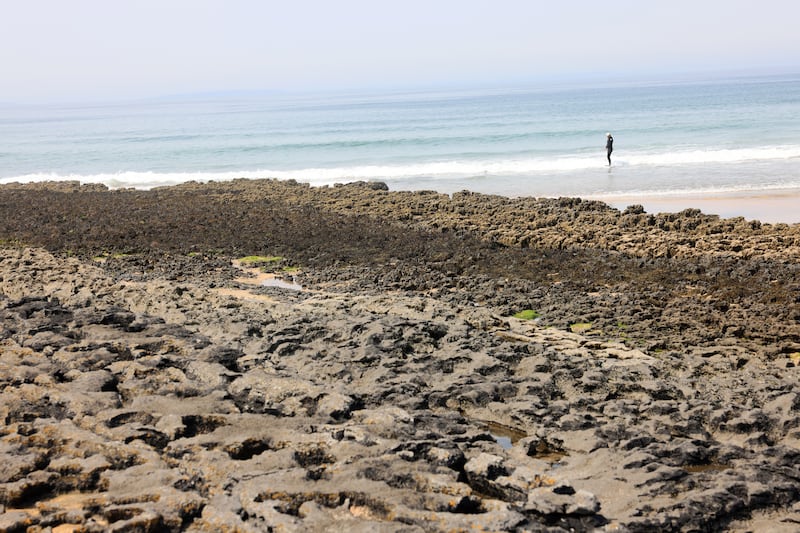
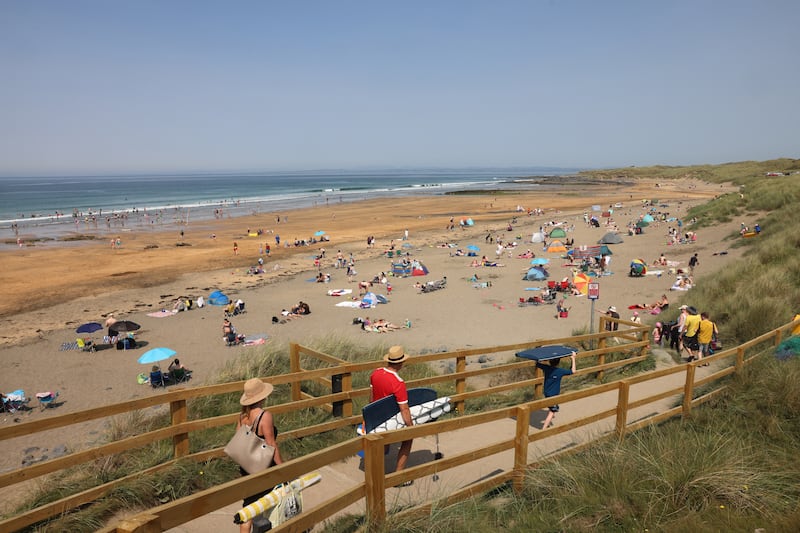
I leave O’Dea, thinking about the importance of ensuring that increased tourism doesn’t take anything from the Burren. The place is precious. Not everybody understands exactly how precious – at a restaurant in Kinvara, on the way home, I ask a young waitress who looks a bit like a teenage Drew Barrymore, what she thinks of the Burren.
“I don’t go in there much, to be honest,” she says. “It’s just rocks.” We both laugh.
Later, driving away, back into the bustle of Galway, I feel sad leaving it all behind. The vast open spaces. The wildness. The water. The people. The magic. With apologies to the young woman in the restaurant, the Burren is so much more than just rocks. It’s the best place to holiday in Ireland. I miss it already.
The Best Place to Holiday judging panel, chaired by Conor Goodman, were: Nadia El Ferdaoussi, travel blogger; Cillian Murphy, county councillor and tourism entrepreneur; Trevor White, director of the Little Museum of Dublin; and Irish Times journalists Rosita Boland and Mary Minihan.



















